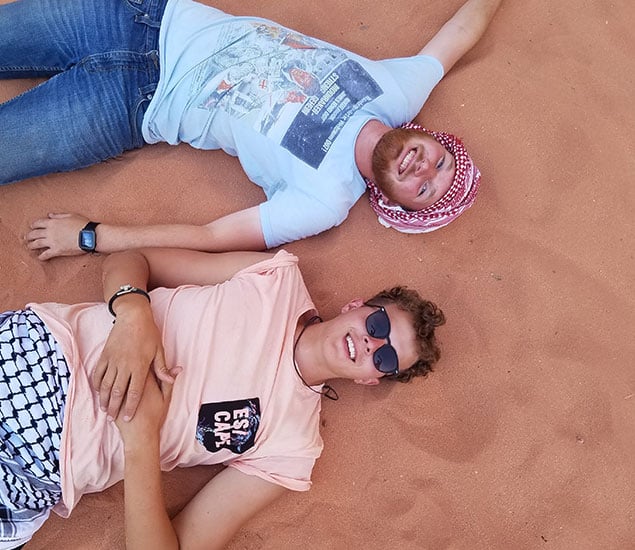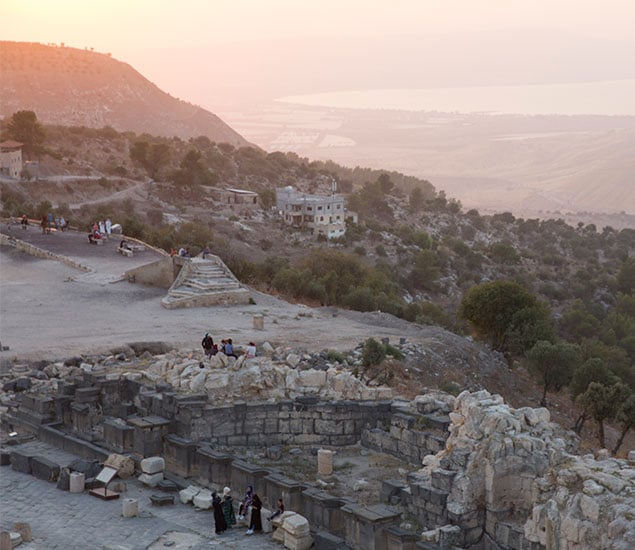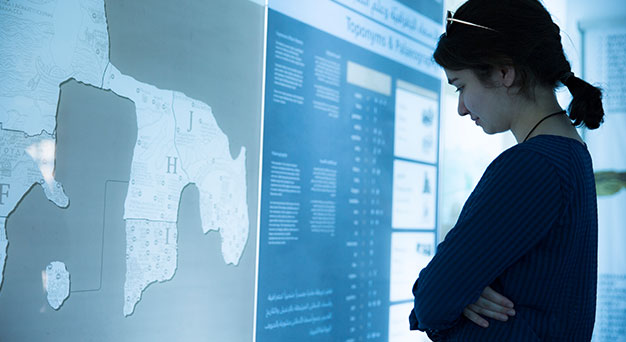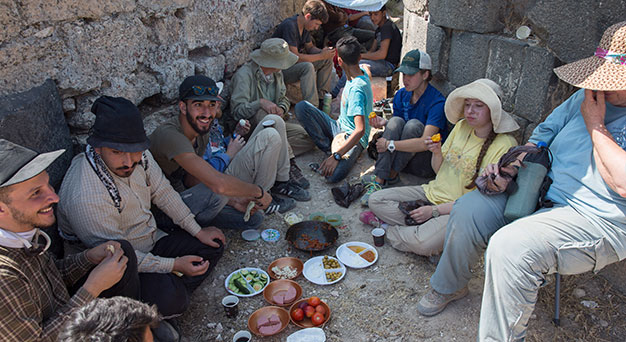- Give
- Alumni and Parents
John Brown University
2000 W. University St., Siloam Springs, AR 72761479-524-9500
jbuinfo@jbu.edu
The Abila Archaeological Project is an archaeological excavation that takes place in northern Jordan. Abila's rich history dating from the Chalcolithic period all the way into the later Islamic periods makes it a site with enough history to interest almost anyone.
Abila is most well known as one of the cities of the Hellenistic league known as the Decapolis, and then as the home of five prominent churches during the Byzantine period. We are very excited to share with you the archaeological drama of one of the most dynamic sites in Jordan. Please explore to learn more about the riches of Abila of the Decapolis, and consider joining us for our next season of excavation!
be an archaeologist.
Summer study programs for JBU students

Jordan summer studies
Earn 12 hours of credit as you explore Jordan and Israel over the course of several weeks.
Courses
- BBL 4453: Art and Archaeology of Jordan (Art Core)
- BBL 2043: Christian Formation (Bible Core)
- BBL 2013: Evangelical Theology (Bible Core)
- RPH 3533: Introduction to Islam (Humanities Core)
- Intercultural Engagement (3 hour requirement met)
Bible land studies trip
Explore Biblical sites in the Middle East and earn your global studies requirement. The Bible land summer study trip occurs in odd years.

Summer studies photos
Explore photos from our summer studies programs in the Middle East!






























Abila project history
In the preface of the first publication on the site of Abila in 1889, Guy Le Strange says of Abila, "The ruins were evidently of very considerable extent, and show the remains of buildings that must have boasted originally no inconsiderable architectural splendor." This is an accurate depiction of one of the most splendid sites in northern Jordan. Abila of the Decapolis is rich with archaeological history. The site boasts a saga that reaches back to a time before Abraham, Isaac, and Jacob. But its visible remains, to which Guy Le Strange referred to, give testimony to a glorious time when Abila reached its zenith in culture, economy, and politics. This was the Abila of the Roman and Byzantine periods.
Background information on Abila
The Decapolis was a group of ten cities (Abila, Damascus, Dion, Gerasa, Gadara, Hippos, Pella, Philadelphia, Raphana, Scythopolis) that formed a Hellenistic or Greco-Roman confederation or league located south of the Sea of Galilee in the Transjordan. Abila lies about three miles south of the Yarmuk River (nahr el-Yarmuk), the modern border between Jordan and Syria. The only city belonging to the Decapolis located to the west of the Jordan River is Scythopolis, ancient Beth Shan.
Abila, along with other cities of the Decapolis, is mentioned in other extant ancient documents.
More details
The Decapolis & Abila in the Bible
Joseph mentions Abila falling into the hands of Antiochus the Great (Antiquities 12:3:136). Pliny also gives mention to Abila (Natural History, 5, 74). Eusebius mentions in his Onomasticon that Abila is "twelve Roman miles from Gadara. The term "Decapolis" is a misnomer, for according to the second century A.D. geographer, Ptolemy, the Decapolis included more than ten cities (Geography 5:14:22). Ptolemy adds nine additional cities to his list: Heliopolis (Baalbak), Abila (Quailibah), Saana (Janamyn), Ina, Abila of Lysanias, Capitolias (Beit Ras), Adra, Gadora (Umm Qeis), and Samoulis.
Although Abila is not mentioned in the Scriptures by name, the term "Decapolis" is specifically referred to three times, with connection to Jesus' ministry: Matthew 4:25 ("Large crowds from Galilee, the Decapolis, Jerusalem, Judea and the region across the Jordan followed him."); Mark 5:20 ("So the man went away and began to tell in the Decapolis how much Jesus had done for him. And all the people were amazed."); and Mark 7:31 ("Then Jesus left the vicinity of Tyre and went through Sidon, down to the Sea of Galilee and into the region of the Decapolis.") [NIV]. It is also alluded to in several places throughout the Bible.
The name "Abila"
The Greco-Roman name "Abila" is preserved in the Arabic toponym (placename), Tel Abil. Abila is an adaptation of the Semitic form, Abel. Abel is the Hebrew word for: perennial stream; watercourse; canal; or brook (Deut.8:2,3,6). This is important when considering the topography of the site, for Tel Abil has a fine perennial stream that flows from its source, Ain Qwailibah, located about one kilometer south of the site. The stream runs north and then turns slightly northwest, emptying into the Yarmuk River and eventually into the Jordan River.
Abila & Jesus
One very important consideration that provides understanding of the strategic location and prominence of these cities in the Decapolis league is found in Mark 7:31: (“Then Jesus left the vicinity of Tyre and went through Sidon, down to the Sea of Galilee and into the region of the Decapolis.“) [NIV]. Jesus considered this region important enough to visit! This lends credence to the idea that these cities were prominent in antiquity. Did Jesus’ itinerary include Abila? This question may never be answered conclusively, due to the lack of hard evidence, but it goes without saying that Abila was a very important city, within close proximity to Galilee, being only 12 Roman miles from Gadara. It was located on a strategic route from Nabataea to Damascus, and it had a bountiful water source and equally bountiful agricultural lands. One must remember the words of the Egyptologist, Kenneth Kitchen, “Absence of evidence is not evidence of absence." Whether Jesus actually visited Abila physically we may never know, but He was certainly represented there spiritually as the abundance of Christian art and architecture loudly testifies.
Discovery of the site
The first European explorer to examine the ruins of Abila was Ulrich Seetzen, the German scholar best known as the "discoverer" of Gerasa (Jerash). In January 19, 1806, dressed as an Arab sheik, Seetzen and his Arab guide left Damascus on horseback and reached the ruins of Tell Abil on February 25, 1806. He found the city in utter ruins with no monument standing, but he does not fail to remark that the former glory of the city was very evident. Johann Burckhardt, most famous for his "discovery" of the rose-red city of Petra, came close to visiting Abila but decided to visit Umm Qeis instead, less than 12 miles from Abila (1812).
More details
More on the discovery of the site
In February of 1888, with the aegis of the newly formed German Society for the Exploration of Palestine--patterned after the British Palestine Exploration Fund--C.E. Gottlieb Schumacher crossed the Wadi el-Kueilby from the east. In front of him stood the impressive ruins of Abila of the Decapolis. The site had been generally known by the local bedouin as El Kueilby (Kueilby being the diminutive form of the Arabic word for "well." Hence the name means "small/little well"). Said Schumacher, "We were thus on the very spot discovered by Seetzen on the 25th of February, 1806, which he considered to be the Abila of the Decapolis, and which, to my knowledge, has not been visited or described by any subsequent explorer."
Nelson Glueck included Abila in his extensive survey of Transjordan in the 1930's and 40's. Although he does not mention much about the site, he does remark that it served as an easy quarry for nearby villages to pillage for the purpose of constructing their homes. Glueck suggested that Abila is a possible candidate for Abel Meholah, home of the Old Testament prophet Elijah: 1.) The modern name preserves the Semitic "Abel." 2.) The site is furnished with a substantial perennial stream, and 3.) The site is situated on one of the direct roads to Damascus. Glueck's collection and identification of the sherds from Abila is his major contribution to the investigation of the site.
Modern expeditions
In the summer of 1979, W. Harold Mare of the Covenant Theological Seminary in Saint Louis, Missouri traveled to Jordan to explore possible excavation sites in northern Jordan. As a Professor of New Testament studies, he was especially interested in the Decapolis region. He visited Tell Abil with his daughter Myra (Mare) Ovshak. He later applied to the Department of Antiquities of Jordan for a permit to conduct an archaeological survey at Abila. Thus began a new era in the history of the research of Abila. Dr. Mare's American team would conduct the first extensive archaeological examination of Abila.
Archaeological history
Surface sherding (surface survey) conducted in 1980 by Dr. Harold Mare and team revealed that Abila's history extended to the Iron and Early Bronze periods. Excavations at the site have conclusively shown that the archaeological history actually reaches back even to the Neolithic Age (8000 B.C.-4000 B.C.). At present, the Greco-Roman, Byzantine and Islamic periods are the main focus of investigation.
Artistically, the site has yielded beautiful mosaics. Those in Area A provided a grand path from the North-South Cardo Maximus (main road) leading up to the entry level of the impressively constructed, tri-apsidal basalt church. This, with six other basilicas, three water tunnels, and a plethora of other exciting finds shows that the population at Abila during the Late Roman and Early Byzantine periods was quite considerable. One find revealed an inscription located in one of the water tunnels of Umm el 'Amad. It indicated that Abila had a bishop (episcopos) in the mid-sixth century. The investigation and survey of the subterranean/hydraulic system found that it was very extensive.
Again, this substantiates the extensive occupation and activity of the Byzantine Christians in Transjordan during the sixth century. Significant evidence is coming to light from excavations being carried out at other Decapolis sites. Work has and is being done at Scythopolis (Beth Shan), Philadelphia (Amman), Heliopolis (Baalbak), Damascus, Gadara (Umm Qeis), Gerasa (Jerash), and Pella (Tabaqat Fahl).







